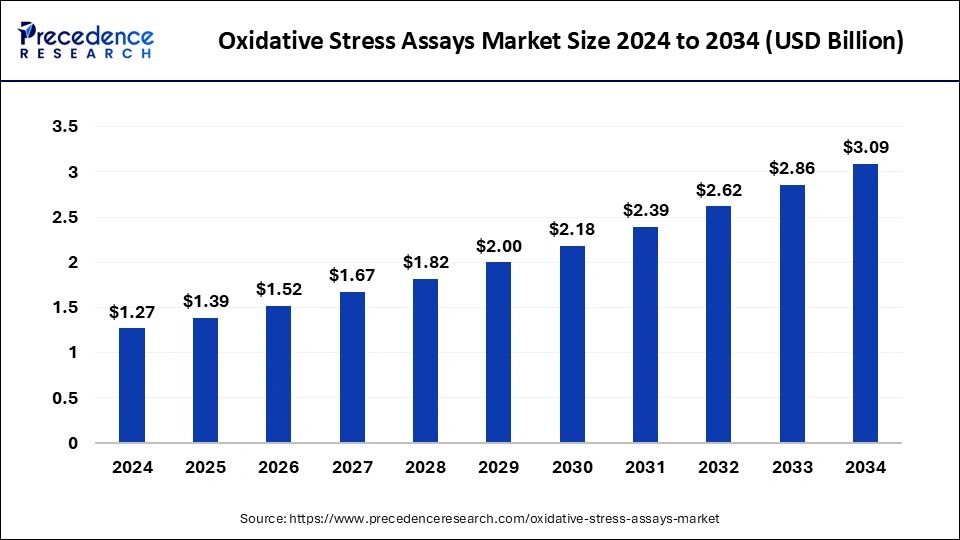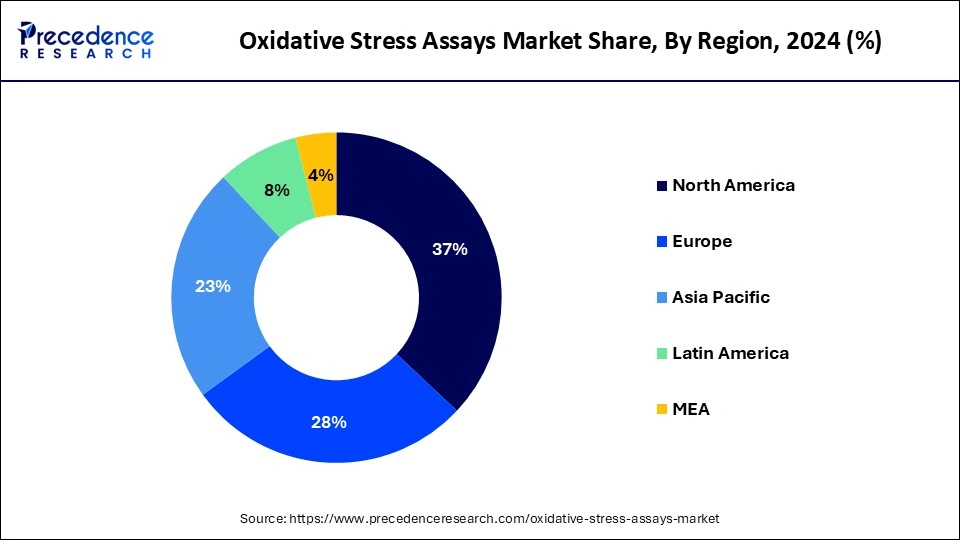December 2024
The global oxidative stress assays market size is accounted at USD 1.39 billion in 2025 and is forecasted to hit around USD 3.09 billion by 2034, representing a CAGR of 9.30% from 2025 to 2034. The North America market size was estimated at USD 470 million in 2024 and is expanding at a CAGR of 9.26% during the forecast period. The market sizing and forecasts are revenue-based (USD Million/Billion), with 2024 as the base year.
The global oxidative stress assays market size was calculated at USD 1.27 billion in 2024 and is predicted to increase from USD 1.39 billion in 2025 to approximately USD 3.09 billion by 2034, expanding at a CAGR of 9.30% from 2025 to 2034. The oxidative stress assay benefits include high output analysis of many small molecule antioxidants and oxidation products from many sample sources like urine, saliva, blood, and blood cells, which will provide a truer and more comprehensive picture of the state of oxidative stress and antioxidant status of the whole body. These factors help to the growth of the market.

The U.S. oxidative stress assays market size was exhibited at USD 330 million in 2024 and is projected to be worth around USD 840 million by 2034, poised to grow at a CAGR of 9.79% from 2025 to 2034.

North America dominated the oxidative stress assays market in 2024. The presence of many healthcare infrastructures, research institutes, and pharmaceutical & biotechnology industries helps the growth of the market in North America. The U.S. is the leading country for the growth of the market in the North American region.

Asia Pacific is estimated to be the fastest-growing during the forecast period of 2025-2034. Increased investment in research and development by research institutes, pharmaceutical industries, and government funding helps the growth of the oxidative stress assays market in the Asia Pacific region.
The oxidative stress assays market deals with clinical laboratories, contract research organizations, academic research institutes, and pharmaceutical & biotechnology industries for various applications, including screening drug candidates, analyzing antioxidant qualities, and determining how they affect pathways linked to oxidative stress. Oxidative stress assays may measure levels of cellular antioxidants or levels of toxic reactive oxygen species.
Many types of tests are available on the market, including reactive oxygen species-based assays, enzyme-based assays, antioxidant capacity assays, indirect assays, etc. These factors help to the growth of the market. Oxidative stress is an imbalance of antioxidants and free radicles in the body that leads to cell damage and diseases like cancer, heart disease, and Alzheimer’s disease. There is a need for oxidative stress assays and products like consumables, services, and instruments that help the growth of the market.
| Report Coverage | Details |
| Market Size by 2034 | USD 3.09 Billion |
| Market Size in 2025 | USD 1.39 Billion |
| Market Size in 2024 | USD 1.27 Billion |
| Market Growth Rate from 2025 to 2034 | CAGR of 9.30% |
| Largest Market | North America |
| Base Year | 2024 |
| Forecast Period | 2025 to 2034 |
| Segments Covered | Product, Test, Technology, Disease, End-use, and Regions |
| Regions Covered | North America, Europe, Asia-Pacific, Latin America, and Middle East & Africa |
Increasing cases of chronic diseases
An increasing imbalance of antioxidants and free radicles in the body leads to cell damage and chronic diseases like cancer, heart disease, and Alzheimer’s disease, which need oxidative stress assays. Free radicles are increased due to both exogenous and endogenous sources. Ischemia, inflammation, cancer, infection, immune cell activation, aging, mental stress, and excessive exercise are all responsible for endogenous free radicle production. These factors help the growth of the oxidative stress assays market.
High cost and lack of awareness
High cost and lack of awareness related to oxidative stress assay products like instruments, services, and consumables may restrict the growth of the market. Lack of skilled professionals and lack of awareness leads to higher turnover, overconfidence, poor judgment, and reduced team success. Disadvantages in protein-based assay include error-proneness with complex samples or protein mixtures, absorbance being affected by ionic strength and pH, and sensitivity to contamination from salts, buffers, and biological materials. These factors may restrict the growth of the oxidative stress assays market.
Research & development and advanced technologies
Increased research & development activities in pharmaceutical and biotechnology companies, academic research institutes, cosmetic companies, contract research organizations, and clinical laboratories help to the growth of the market. Use of advanced oxidative stress assay kits and reagents for the growth of the market. XF Palmitate advanced assay oxidation stress kit, dyes, and kits used for measurement of oxidative stress can help the growth of the market. These factors help the growth of the oxidative stress assays market.
The consumables segment dominated the market in 2024, and it is estimated to be the fastest-growing segment in the forecast period. Consumables for oxidative stress assays include kits and reagents. The benefits of an oxidative stress detection assay kit include early detection, which helps to early detection of oxidative stress occurrence, a quantitative measurement that evaluates intracellular and extracellular oxidative stress levels, and it also provides an intracellular and extracellular oxidative stress view in different cellular compartments. These factors help to the growth of the consumables segment and contribute to the growth of the oxidative stress assays market.
The indirect assays segment dominated the market in 2024. Indirect assays include nucleic acid-based assay, lipid-based assay, and protein-based assay for the detection of oxidative stress. Nucleic acid-based assays are used to detect coronavirus infections, infectious diseases, etc., and organism-specific RNA or DNA sequences extracted from the microorganism. Lipid-based assays are used for the measurement of plasma concentration of triglycerides, cholesterol, LDL- and HDL-cholesterol, determination of lipoprotein, and calculation of non-HDL cholesterol concentration, and they help clinicians to quantify lipid-associated health risks and monitor the effects of treatment.
The protein-based assay is highly used for diagnosing, monitoring, and treatment of cancer patients. These factors help the growth of the indirect assays segment and contribute to the growth of the oxidative stress assays market.
The reactive oxygen species-based assays segment is expected to be the fastest-growing during the forecast period. The ROS (reactive oxygen species) are natural byproducts of cellular oxidative metabolism and play a significant role in the transformation of cell death, cell survival, inflammation-related factor production, cell signaling, and differentiation. Reactive oxygen species contain oxygen radicals, which are highly reactive substances, and these are the key components in cancer therapies. These factors help the growth of the reactive oxygen species-based assays and contribute to the growth of the oxidative stress assays market.
The enzyme-linked immunosorbent assays (ELISA) segment dominated the market in 2024, and it is estimated to be the fastest-growing segment during the forecast period. ELISA tests are simple equipment that uses basic mix-and-wash protocols, which makes them easy to perform in the lab. The basic reagent, the antibody, binds to its target with affordability and offers results with high specificity and high sensitivity. ELISA assays are used highly to detect antibodies, viruses, and autoantigens in whole blood or serum. These factors help the growth of the enzyme-linked immunosorbent assays (ELISA) segment and contribute to the growth of the oxidative stress assays market.
The flow cytometry segment is expected to grow significantly during the forecast period. Flow cytometry is a powerful tool for functional studies, disease research, immunophenotyping, and cell analysis. The benefits of flow cytometry include the ability to collect information from millions of cells in a few moments and to measure a high number of parameters on the same sample. The results of flow cytometry are used for monitoring the health of people who suffer from HIV, for cancer diagnosis and treatment, and for other purposes. It may also be helpful for doctors to figure out how serious a cancer can be and how it will respond well to a specific treatment. These factors help to grow the flow cytometry segment and contribute to the growth of the oxidative stress assays market.
The cardiovascular disease segment dominated the market in 2024. Oxidative stress assay is helpful for the treatment of cardiovascular disease. Cardiovascular disease may affect the heart and the blood vessels. Oxidative stress plays an important role in generating ROS (reactive oxygen species). An oxidative stress assay is needed to reduce oxidative stress in cardiovascular disease. These factors help the growth of the cardiovascular disease segment and contribute to the growth of the oxidative stress assays market.
The cancer segment is expected to be the fastest-growing during the forecast period. The oxidative stress assay can detect heterogeneous reactive oxygen species and antioxidant production in tumors and across lesions. These factors help to the growth of the cancer segment and contribute to the growth of the oxidative stress assays market.
The pharmaceutical & biotechnology industries segment dominated the oxidative stress assays market in 2024. In the pharmaceutical & biotechnology industries, new treatments and many therapeutic drug developments, rapid and precise development of vaccines and medicine can help the growth of the market.

The contract research organizations segment is estimated to be the fastest-growing during the forecast period. The benefits of contract research organizations include bringing new treatments, accelerating drug development, flexibility in services provided on a contract basis, increased efficiency because of specialized support, reduced cost as compared to conducting trials in-house and acquiring expert knowledge and resources in clinical research. These factors help to the growth of the contract research organizations and contribute to the growth of the oxidative stress assays market.
By Product
By Test
By Technology
By Disease
By End-use
By Geography
For inquiries regarding discounts, bulk purchases, or customization requests, please contact us at sales@precedenceresearch.com
No cookie-cutter, only authentic analysis – take the 1st step to become a Precedence Research client
December 2024
January 2025
February 2025
August 2024